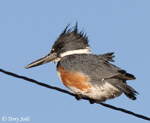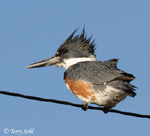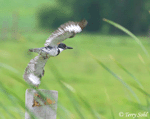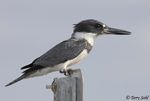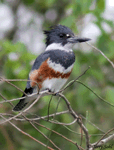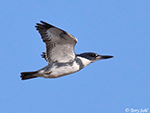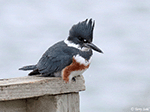| Length: 12 to 14 inches | Wingspan: 22 to 26 inches | Seasonality: Summer / Migrant |
| ID Keys: Long thick black bill, white neck collar, crested head, blue-gray upperparts | ||
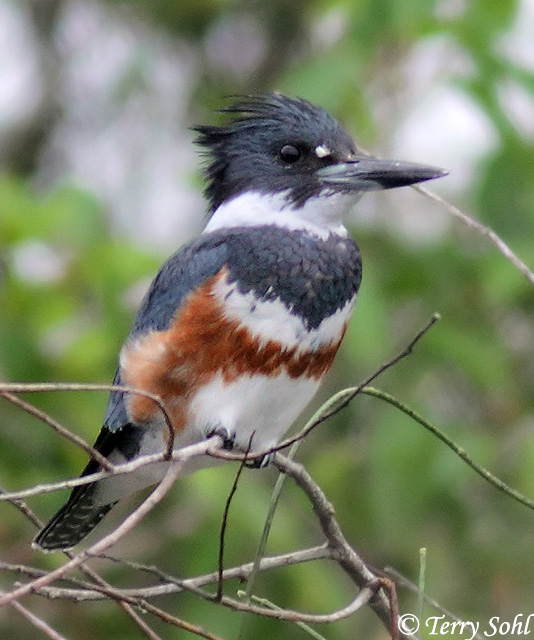 The Belted Kingfisher can
often be spotted on a perch overlooking the water, with its head down as it
scans the water below for suitable prey. They are plunge divers, diving
headfirst to grab prey (usually small fish) near the water's surface. Unlike
many bird species, the female is more colorful than the male, as she has a chestnut colored band
across the belly (see photo to the right) that the male lacks. While they are
the only Kingfisher species found in South Dakota, there are number of other
kingfishers found in North America, primarily in more tropical climates.
The Belted Kingfisher can
often be spotted on a perch overlooking the water, with its head down as it
scans the water below for suitable prey. They are plunge divers, diving
headfirst to grab prey (usually small fish) near the water's surface. Unlike
many bird species, the female is more colorful than the male, as she has a chestnut colored band
across the belly (see photo to the right) that the male lacks. While they are
the only Kingfisher species found in South Dakota, there are number of other
kingfishers found in North America, primarily in more tropical climates.
Habitat:
Can be found near practically any aquatic habitat, especially in the winter and the fall. They are more particular in the summer, when they require aquatic habitats with nearby dirt banks for their nesting burrows.
Diet:
Primarily feeds on small fish. They will also eat other aquatic animals including frogs, tadpoles, crayfish, and aquatic insects. They occasionally feed away from water and will take mice and other small rodents, lizards, small snakes, and small birds.
Behavior:
Observes from a perch over water, plunging head first into the water after prey when spotted. Also will hover over water in search of prey.
Nesting:
May through July. Belted Kingfishers nest in burrows, typically dug in the side of a dirt bank. While that often is near water (such as in the vertical face of a dirt river bank), they will sometimes nest relatively far from water, using areas such as quarries or simply the side of a ditch. The burrow is constructed by both the male and female, and consists of a tunnel 2 to 6 feet deep, slightly rising from the entrance, and ending with a nesting chamber. The female lays between 5 and 8 eggs, and both parents help to incubate them. The eggs hatch after about 22 days, with the young fledging from the nest about 4 weeks after hatching.
Interactive eBird Map:
Click to access an interactive eBird map of Belted Kingfisher sightings
Song:
The most commonly heard vocalization is a long, dry rattling, heard when birds are disturbed, or sometimes as calls between interacting Kingfishers.
- 1Click here to hear the dry rattle call of a Belted Kingfisher
- 2Click here to hear the interactions of multiple Belted Kingfishers
Migration:
Summers throughout the U.S. and Canada. Birds in the northern part of its range usually migrate southward in the fall, but they can be found in winter in the north as long as open water is available. They are generally a rare occurrence in South Dakota in the winter, however.
Similar Species:
Similar to other Kingfishers, but the Belted Kingfisher is the only one found in South Dakota. In Texas, possibly confused with the Ringed Kingfisher, a much larger species.
Conservation Status:
Belted Kingfishers are found across a very broad geographic range and are common in parts of that range. Their overall numbers also appear to be stable. The IUCN considers the Belted Kingfisher to be a species of "Least Concern".
Further Information:
Photo Information:
December 10th, 2012 - Big Cypress National Reserve, Florida - Terry Sohl
Additional Photos:
Click on the image chips or text links below for additional, higher-resolution Belted Kingfisher photos.
Audio File Credits:
- 1Ian Cruickshank. Recorded in Vancouver Island, British Columbia on September 20th, 2012. Original recording and information from xeno-canto.
- 2Jonathon Jongsma. Recorded in Lake Bemidji State Park in Minnesota on May 6th, 2013. Original recording and information from xeno-canto.
| Click on the map below for a higher-resolution view |
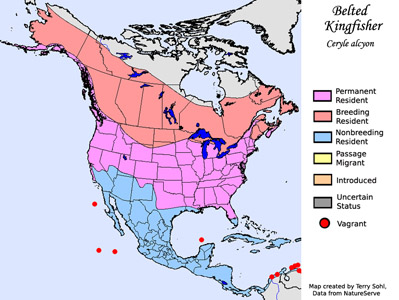 |
| South Dakota Status: Common migrant and uncommon Summer resident throughout the state. Uncommon winter resident, most common in the southern part of the state. |
Additional Belted Kingfisher Photos
Click for a higher-resolution version of these photos
